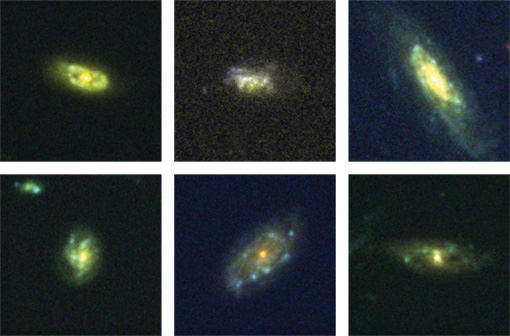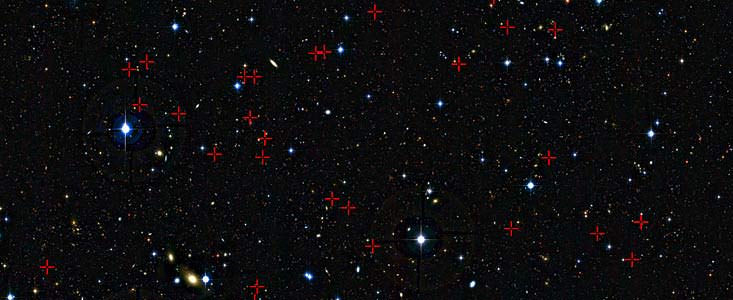[/caption]
Got a teenager? Then you know the story. Go to look for your favorite bag of chips and they’re gone. You eat one portion of meat and they need three. If you like those cookies, then you better have a darn good place to stash them. And, while you’re at it, their car needs gas. Apparently there’s a reason for the word “universal”, because teenage galaxies aren’t much different. Thanks to some new studies done by ESO’s Very Large Telescope, astronomers have been able to take a much closer look at adolescent galaxies and their “feeding habits” during their evolution. Some 3 to 5 billion years after the Big Bang they were happiest when just provided with gas, but later on they developed a voracious appetite… for smaller galaxies!
Scientists have long been aware that early galaxy structures were much smaller than the grand spirals and hefty ellipticals which fill the present Universe. However, figuring out exactly how galaxies put on weight – and where the bulk supply comes from – has remained an enigma. Now an international group of astronomers have taken on more than a hundred hours of observations taken with the VLT to help determine how gas-rich galaxies developed.
“Two different ways of growing galaxies are competing: violent merging events when larger galaxies eat smaller ones, or a smoother and continuous flow of gas onto galaxies.” explains team leader, Thierry Contini (IRAP, Toulouse, France). “Both can lead to lots of new stars being created.”
The undertaking is is MASSIV – the Mass Assembly Survey with the VIsible imaging Multi-Object Spectrograph, a powerful camera and spectrograph on the VLT. It’s incredible equipment used to measure distance and properties of the surveyed galaxies Not only did the survey observe in the near infrared, but also employed a integral field spectrograph and adaptive optics to refine the images. This enables astronomers to map inner galaxy movements and content, as well as leaving room for some very surprising results.
“For me, the biggest surprise was the discovery of many galaxies with no rotation of their gas. Such galaxies are not observed in the nearby Universe. None of the current theories predict these objects,” says Benoît Epinat, another member of the team.
“We also didn’t expect that so many of the young galaxies in the survey would have heavier elements concentrated in their outer parts — this is the exact opposite of what we see in galaxies today,” adds Thierry Contini.
These results point towards a major change during the galactic “teenage years”. At some time during the young Universe state, smooth gas flow was a considerable building block – but mergers would later play a more important role.
“To understand how galaxies grew and evolved we need to look at them in the greatest possible detail. The SINFONI instrument on ESO’s VLT is one of the most powerful tools in the world to dissect young and distant galaxies. It plays the same role that a microscope does for a biologist,” adds Thierry Contini.
The team plans on continuing to study these galaxies with future instruments on the VLT as well as using ALMA to study the cold gas in these galaxies. However, their work with gas isn’t the only “station” on the block. In a separate study led by Kate Rubin (Max Planck Institute for Astronomy), the Keck I telescope on Mauna Kea, Hawaii, has been used to examine gas associated with a hundred galaxies at distances between 5 and 8 billion light-years – the older teens. They have found initial evidence of gas flowing back into distant galaxies that are actively forming new stars.

Apparently, like a teenager with the munchies, matter finds its way into those galactic tummies. One feeding theory is an inflow from huge low-density gas reservoirs filling the intergalactic voids… another is huge cosmic matter cycle. While there is very little evidence to support either hypothesis, gases have been observed to flow away from some galaxies and may be moshed around by several different sources – such as supernovae events or peer pressure from gigantic stars.
“As this gas drifts away, it is pulled back by the galaxy’s gravity, and could re-enter the same galaxy in time scales of one to several billion years. This process might solve the mystery: the gas we find inside galaxies may only be about half of the raw material that ends up as fuel for star formation.” says Dr. Rubin. “Large amounts of gas are caught in transit, but will re-enter the galaxy in due time. Add up the galaxy’s gas and the gas currently undergoing cosmic recycling, and there is a sufficient amount of raw matter to account for the observed rates of star formation.”
It might very well be a case of cosmic recycling… but I’d feel safer hiding my cookies.
Original Story Sources: ESO News Release and MPIA Science News Release. For Further Reading: Research Paper 1, Research Paper 2, Research Paper 3 and Research Paper 4.

